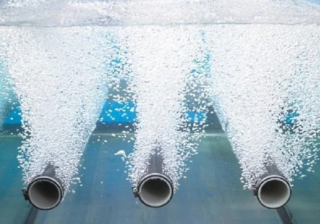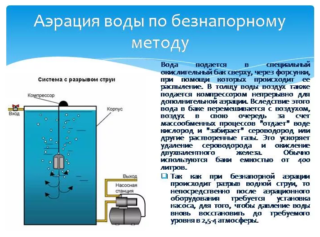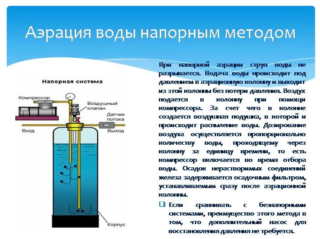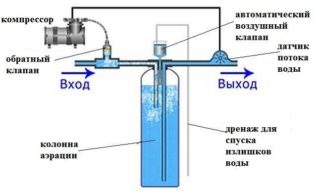The quality of drinking water directly affects health, human life expectancy. Therefore, proper water treatment is so important both in private estates and in industrial enterprises. One of the most effective types of equipment in the fight against impurities is an aeration column for water purification from iron. This method allows you to eliminate Fe2 particles as much as possible and significantly improve the color and smell of the liquid.
What is water aeration and the scope of the method

Aeration is a special process that implies the saturation of water with oxygen, its kind of airing and softening. Due to the oxidative processes occurring during this, iron molecules acquire the form of suspensions (a trivalent insoluble compound visible to the human eye), which can be removed. With the help of oxygen, hydrogen sulfide and carbon dioxide are also removed from the water.
Aeration is performed either by spraying a liquid or by passing oxygen bubbles through it.
This cleaning method is used:
- in biological VOCs that process effluents to support beneficial bacteria;
- at water treatment plants, in municipal VOCs, rotary aerators are more often used;
- for proper treatment of water from a well if it is saturated with iron or hydrogen sulfide;
- pharmaceutical, food industry;
- Agriculture;
- fish farms, artificial pools - they use a floating turbo aerator in the form of a small catamaran;
- home aquariums - for these purposes it is better to use a ceramic aerator, which neutralizes the carbon dioxide accumulated in the tank.
After soluble impurities take the form of suspensions, they are removed using special filters. If this is not done, debris particles will disable the operation of the pumping equipment, contaminate the bottom of the storage tank.
Methods and principle of action
- Free-flow. The cheapest way to saturate a liquid with oxygen. This means simply settling the collected water in a tank. For a certain period of time, its entire volume will be saturated with oxygen and the iron will fall out into a rusty sediment. This method, apart from simplicity, does not give anything positive. The site owner is forced to use only the top of the treated medium. The lower one must either be drained or passed through additional filters. In addition, with such aeration of water, you have to regularly wash the walls of the tank from the accumulated bloom and mucus.
- Ejection. The venturi unit acts as an ejector. When liquid is transported through it, air is simultaneously drawn into the impeller. Due to this, the water is treated with oxygen. Despite the fact that ejection plants operate without electricity consumption, they are in low demand. The reason for this is the lack of efficiency of the mechanism. Strong pollution does not lend itself to it.
The method of aeration of liquid for a private house is chosen depending on the financial capabilities of the family, type of residence (permanent / temporary). After saturation of water with oxygen, its high-quality filtration is important.
The device of water aeration systems
- Column aeration for collecting water. It looks like a tall cylinder made of fiberglass reinforced plastic.
- Counter (flow meter).
- Compressor.
- Air safety valve. It works to remove gases and excess oxygen from the storage cylinder.
The compressor pumps oxygen into the flask, where the gas quickly mixes with the liquid. Its molecules displace all divalent impurities and gases from the water. Then the processed medium moves to special filters. Here, all suspended matter is removed, and a pure liquid is supplied to the water supply system.
The gravity aeration system is designed as follows:
- The large tank is equipped with a special valve. It controls the flow of liquid into the tank. It is desirable that the container is half full. This allows the air to mix more intensively with the molecules of the humid environment.
- The blower fan is responsible for supplying air to the tank, the exhaust fan removes the oxidized gases from the tank.
Also, for a non-pressurized installation, special sensors are provided that control the on / off of equipment: fans, inlet and outlet nozzles, waste liquid drain. Additionally, such stations can be equipped with a jet crushing function.
A blower for aerating wastewater treatment plants is often used in septic tanks to increase the activity of bacteria.
Electrochemical equipment has the following working units:
- electrolyzer with cathode and anode;
- continuous current source;
- branch pipes for supplying and removing liquid;
- an electromagnetic processing unit connected to a continuous current source.
When water enters the reservoir, the unit connected to the power supply ensures that the field voltage changes synchronously with the level of its hardness. Thus, water is deferrized and energy consumption is controlled.
Advantages and disadvantages of the method
For aeration as a way of purifying water in aquariums, ponds or taken from a well / well, the following advantages are characteristic:
- Oxygen safety. The gas used to process the medium is non-toxic, free of charge, and has a fast oxidizing effect. Oxygen does not form compounds hazardous to humans.
- When using pressure aeration, it is possible to significantly reduce the dimensions of the installations. In turn, this allows you to save space on the site / in the house, which cannot be said when using free-flow installations.
- No need to use additional expensive reagents for high-quality water treatment.
- Full automation of the process. This frees the master from labor costs, the need to control the operation of treatment systems.
- A clear diagram of the installation of equipment, the principle of its maintenance.
Installation of a pressure or gravity system can be carried out even by a master without experience.











